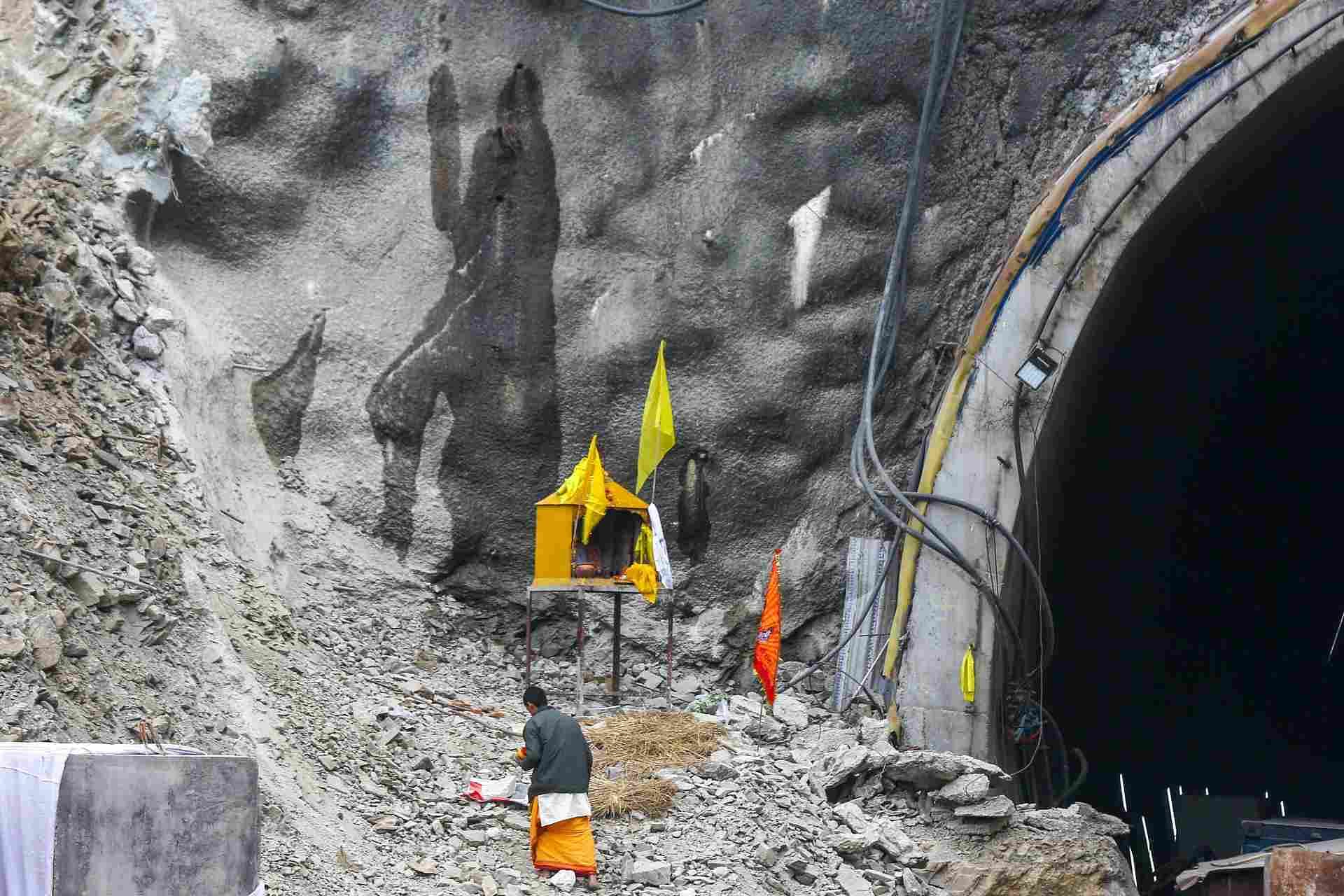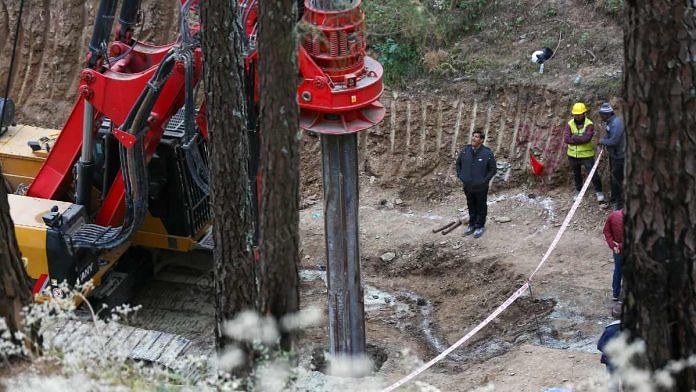Uttarkashi: It’s been 16 days since the under-construction Silkyara tunnel collapsed in Uttarakhand, trapping 41 workers.
For over two weeks, the family members of the workers have been coming to the site to follow the rescue operation. Every day is a new mental tug of war between hope, and the realisation that it’s not time yet.
On the one hand, say family members, there’s 24×7 TV news coverage, with breathless reporters telling their audience the workers will be out “in just a few hours”.
On the other is the ground reality, where caution is being urged against any rush to retrieve the men.
Australian tunnelling expert Arnold Dix, who has been helping the Indian authorities in the rescue operations, has talked about the potential costs of haste, while promising that the men will be home by Christmas, which is a month away.
“It is my job to bring them out safely,” Dix told ThePrint. “This is not a game. If we rush, we may lose them.”
Dix said he never promised that rescue operations would go smoothly and end quickly.
The National Disaster Management Authority (NDMA) also said Saturday that they never gave out any timeline. “Earlier, there were not many complexities and that is why some people in the media were assuming timelines,” said NDMA member Lt Gen Syed Ata Hasnain.
The uncertainty is taking a toll.
Rajni, wife of Virendra Kishku, one of the 41 workers, said the family is in a daily battle against hope. “We hope every day that he will come out today, even the TV keeps showing it,” said the Banka, Bihar, native. “But we are feeling scared.”
“As soon as he comes out, I will take him home,” she said. “Char paisa kam kamayenge, lekin surakshit rahenge (We’ll earn less, but at least he’ll be safe at home).”
Chaudhary, an agricultural labourer from Lakhimpur Kheri in Uttar Pradesh, speaks in the same vein. He has already lost one son — in an accident in Mumbai — and the thought of losing another child has him shivering with fear.
Once his son Manjeet comes out, he said, he will “never let him work here again”. “I do not want to lose my second son,” he added.
Each day the rescue operation stretches, anxiety peaks. “Manjeet is my only son,” he said. “If something happens to him, how will my wife and I live?”
After the American auger machine deployed for horizontal digging through the rubble to rescue the workers broke down again, vertical digging through the hill above has begun. By Monday, 31 metres — against a target of 86 metres — had been completed.
Vertical digging, however, is described as a dangerous technique by geology experts, on account of the fragile formations of the “young” Himalayas.
Digging is also under way in two other ways — manual horizontal digging along the same path where the auger machine was deployed, and the construction of a rescue tunnel from the Barkot end of the collapsed tunnel, aided by blasts. The latter will resume after two-days, and is expected to take 12-13 days.

The rescue operation is being carried out by Oil & Natural Gas Corporation (ONGC), power companies SJVN and THDC, Rail Vikas Nigam Limited (RVNL), and National Highways and Infrastructure Development Corporation Limited (NHIDCL), which was implementing the tunnelling project.
On 21 November, the Ministry of Information and Broadcasting issued an advisory to television channels to refrain from sensationalising the ongoing rescue operation, and making any live posts or videos from near the tunnel site.
Prayers & worries
Fervent prayers are under way at the site for the return of the workers, and a makeshift temple has been installed outside the tunnel, where local residents performed a havan Monday. A formation resulting from water seepage at the entrance of the tunnel is being seen by people as an apparition of the Hindu deity Shiva.

Deepak Singh Rawat and his wife Yogita Rawat, who run a dhaba in Brahmakhal, Uttarkashi, said the TV coverage left them more scared everyday. At their family temple, some local people organised Gayatri Mantra chanting Monday for the workers.
A fair dedicated to the local deity Boukhnag (an incarnation of Sheshnag) is currently taking place in Uttarkashi, scheduled to conclude Monday or Tuesday.
Local residents told ThePrint that, once the fair concludes, they plan to visit the site and stage a protest, urging the prompt rescue of the trapped workers.
The families, meanwhile, are staying at a camp set up outside the tunnel by the administration, and they are being made to talk to the trapped workers daily.
Day in and day out, they congregate on an earthen mound 500 metres from the rescue site, seeking a vantage point to the operation.
The vertical drilling began Sunday afternoon.
At a press conference near the site, Additional Secretary, Union Road and Transport Ministry, Mahmood Ahmed, said, “Vertical drilling to make an escape passage for 41 workers trapped inside Silkyara tunnel has begun… a total of 86 metres is to be done which is expected to be completed in two days.”
Ahmed is also the managing director of the National Highways and Infrastructure Development Corporation Limited (NHIDCL).
Environmental and geological experts are watching the operation with trepidation, noting that development work in the region without thorough research is like playing with fire, pointing out that this may well be why the tunnel collapsed in the first place.
“The Himalayas are very young mountains, and their tectonic plates are still in motion, trapped beneath the Tibetan plates,” said geologist Y.P. Sundriyal, referring to reports about the Mount Everest “growing” 86 cm
“Undertaking any work without a thorough ground penetrating report (GPR) would be akin to inviting risks.”
One accident, said Sundriyal, is an alarm bell for the next.
Dix had earlier told ThePrint that “the fragile nature of this tunnel and the rocks — the building of tunnels has to be done carefully”. “That is why it collapsed,” he added.
It’s for the same reasons that questions surround vertical digging as a solution too.
‘Situation like war’
Officials involved in the rescue operation on-site have acknowledged the likelihood of vibrations in the mountains during vertical drilling, which necessitate intermittent halts to the operation.
Former Geological Survey of India director P.C. Nawani said “vertical drilling will shake the mountain, causing vibrations, and debris could potentially fall on the workers, and the rescuers may get hurt themselves”.
Geologist Harsh Vats said vertical drilling could be a “huge threat” to the mountains. “There will be rain in Uttarkashi in the coming days, which will increase the mud as it is a snow-affected area. So, work should be done as early as possible, because after that, it will become more difficult,” he added.
India Meteorological Department senior scientist R.K. Jenamani confirmed to ThePrint that rain is forecast in the state in the next three days.
Sundriyal said “in the area where the tunnel is being constructed, there are rocks like phyllite, flintstone, and clay minerals that tend to break and shrink upon contact with water”.
“Vertical drilling can cause jerking, potentially harming people in villages located atop the mountain,” he added.
Several questions are also being raised about the research done before tunnelling began in Silkyara.
“The rocks of this entire area are fragile and a thorough study was needed before working here,” said geologist S.P. Sati.
The tunnel collapse, Sundriyal added, was a “man-made disaster”. Questioning the detailed project report (DPR) for the project, he said, “whatever was written was not on the ground and the company did not have any full-time miner and geology expert”.
He had earlier alleged that it was caused by negligence on the part of NHIDCL.
“The absence of ground penetrating radar (GPR) in tunnel construction, the lack of emergency exits, and the absence of steel pipes or bars at 2-3 feet intervals were among the causes of the incident,” he told ThePrint, adding that there was a lack of accountability in such cases.
Nawani said, “as a norm, escape routes should be there in such long tunnel projects to facilitate rescue work in case of an emergency”.
Asked about the questions on exit points, Uttarkashi District Magistrate Abhishek Ruhela said in an interview with ThePrint that “this is for the designers to decide”.
“Technical decisions are taken after a lot of studies. There are experts involved too,” he added.
Bernard Gruppe, a European company that provided design services to construction firm Navayuga Engineering Company for the tunnel, said, “since the start of tunnel driving, geological conditions proved to be more challenging than predicted in the tender documents”.
The collapse incident has prompted the central government to order a safety audit of all 29 tunnels under construction on national highways across the country.
The Uttarkashi rescue operation, say officials involved, is unlikely to end soon.
NDMA member Lieutenant General Syed Ata Hasnain (Retd) said Saturday this “operation may take a long time”.
Hasnain said, “You are seeing that this operation is getting technically complex. We are conducting rescue operations on hills. We are working in an environment of unpredictability.
“I have experienced that when you do something with mountains, you cannot predict anything,” he added. “This is exactly a situation like war.”
(Edited by Sunanda Ranjan)
Also Read: Vertical drilling begins in Uttarkashi tunnel to rescue trapped workers. ‘Big risk,’ say geologists



